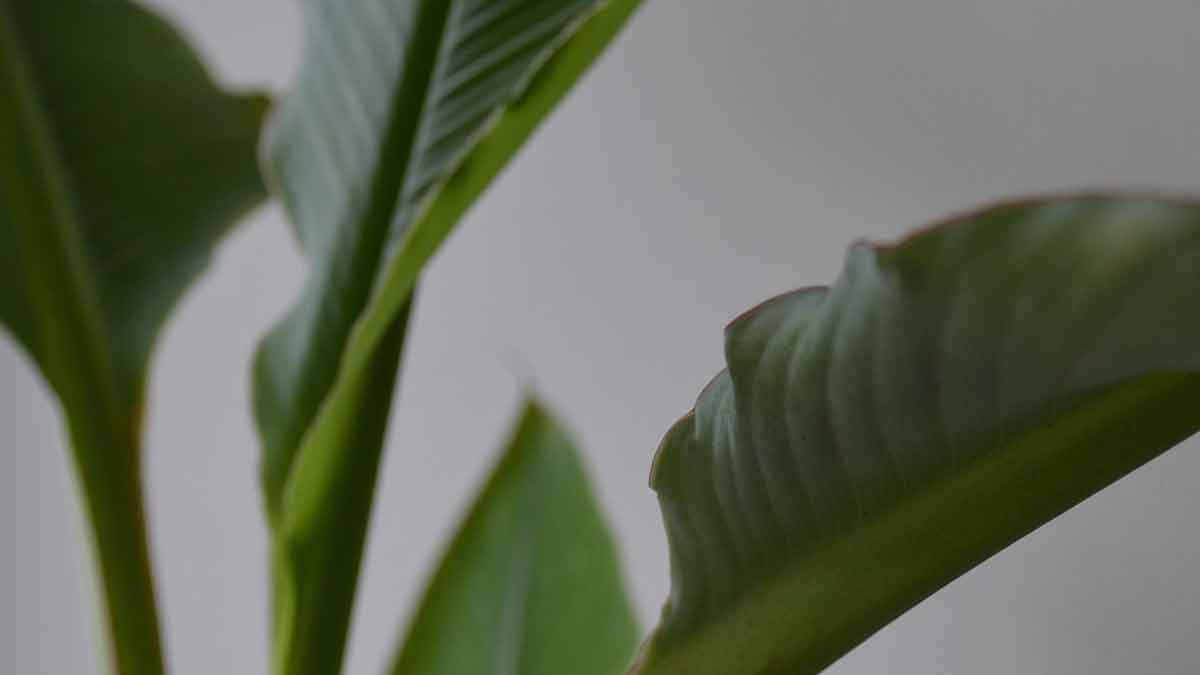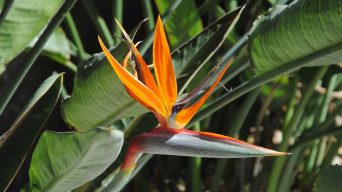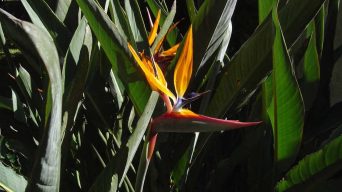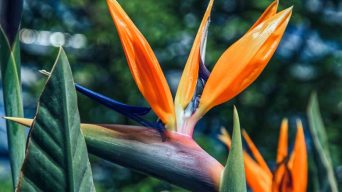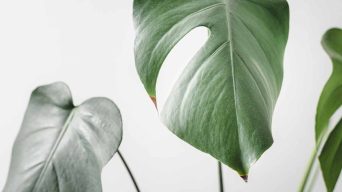Bird of Paradise leaves splitting is normal and allows wind to pass through the leaves. However, factors like irregular watering, lack of humidity, and physical damage can also cause splits. Address underlying issues to prevent further damage.
The lush and vibrant Bird of Paradise is popular among plant enthusiasts for its stunning foliage and exotic appeal.
However, it’s common for the leaves to split or curl, leaving many gardeners perplexed about what went wrong.
Here we’ll unravel the mystery behind splitting Bird of Paradise leaves, delve into the common causes, share valuable tips on how to fix them and reveal preventative measures that will keep your plant thriving.
Reasons Why Bird Of Paradise Leaves Split
Bird of Paradise leaves can split for a variety of reasons.
Underwatering, overwatering, low humidity levels, old leaves, light issues, pests, and diseases are among the causes.
Additionally, environmental stressors can also lead to leaf splitting.
Identifying the underlying cause and taking the necessary steps to prevent further damage is essential.
Underwatering
Underwatering is a common cause of splitting leaves in Bird of Paradise plants, such as Strelitzia reginae and Strelitzia nicolai.
Insufficient water intake can lead to the plant losing its turgidity, resulting in weakened cell walls that eventually split due to their inability to hold up against external pressures.
To remedy this issue, increase the watering frequency while ensuring the soil remains moist but not soggy.
This allows your Bird of Paradise plant to retain adequate moisture levels for optimal growth and health.
One method for proper watering involves checking the top inch of potting mix. If it feels dry, it’s time to give your tropical companion a drink.
Overwatering
One common reason behind Bird of Paradise leaves splitting is overwatering, which can lead to various issues in the plant.
Providing excessive water to your paradise plant makes it difficult for the roots to access oxygen and other essential nutrients.
An example of an overwatered white bird would be when its leaves start curling or turning yellow despite being healthy initially, indicating possible damage from excess moisture.
To avoid this issue with your Paradise plants, monitor their watering needs carefully: instead of sticking to a strict schedule, check if the top inch or two of soil is dry before adding more water.
Additionally, ensure proper drainage by using potting mixtures designed for tropical plants like giant birds and placing them in pots with holes at the bottom.
Low Humidity Levels
Low humidity levels can significantly impact the health of your bird of paradise plant, often leading to the leaves splitting.
This tropical plant, whether the Strelitzia reginae or Strelitzia nicolai variety, thrives in environments with ample moisture in the air.
To prevent and address leaf splitting caused by low humidity levels in your bird of paradise plant’s environment, regularly mist its leaves with water or place a tray filled with water and pebbles nearby.
Alternatively, an indoor humidifier can maintain optimal humidity around your beloved white bird or giant bird plants.
Old Leaves
Old leaves can commonly cause splitting in Bird of Paradise plants.
As the plant ages, its older leaves may deteriorate and become weaker, leading to splits or tears.
You may notice these old leaves also yellowing or browning at the edges.
To address this issue, simply use a pair of clean shears or scissors to trim away any damaged leaves from your Bird of Paradise plant.
This will help improve its appearance and redirect nutrients and resources towards new healthy growth.
Additionally, you should regularly prune your Bird of Paradise plant to remove any dead or dying foliage and stimulate new growth.
Light Issues
Insufficient light is another reason why Bird of Paradise leaves may split.
If your plant lacks bright indirect sunlight, its leaves may start curling or splitting.
This often happens when the plant is grown indoors and isn’t placed near a window that receives adequate lighting.
To prevent this issue, move your plant to an area with plenty of natural light exposure.
Avoid placing it in direct sunlight, as this can damage the leaves.
Pests And Diseases
Another reason Bird of Paradise leaves split and curled is pests and diseases.
Pests that may affect your plant include spider mites, mealybugs, and scale insects.
These pests can damage the leaves, causing them to turn yellow or brown with visible webbing on the underside of the leaves.
Diseases such as fungal infections caused by overwatering, root rot, or bacterial infections can also lead to leaf splitting and curling.
It’s essential to address pest or disease issues promptly since they can spread quickly from one plant to another in a growing area.
Environmental Stressors
Bird of Paradise plants are sensitive to environmental changes, and exposure to specific stressors can cause the leaves to split.
Some environmental factors that can contribute to leaf splitting include extreme temperature fluctuations, low humidity levels, and poor air circulation.
Similarly, if you’re keeping your bird of paradise plant indoors during dry winter or in an air-conditioned room all year round without proper humidification, its leaves may become brittle and prone to splitting.
How To Fix Splitting Bird Of Paradise Leaves
If you’re dealing with splitting Bird of Paradise leaves, there are several steps you can take to fix the issue.
By trimming damaged leaves, repotting in fresh soil, adjusting watering and humidity levels, and addressing pest or disease problems, you can help your plant recover and thrive.
Follow these simple tips to keep your Bird of Paradise looking healthy and beautiful.
Trim Damaged Leaves
If your Bird of Paradise plant’s leaves are splitting and damaged, it is essential to trim them to prevent further harm.
Here are the steps to follow:
- Examine the damaged leaves carefully and identify the affected parts.
- Use a clean, sharp pair of scissors or pruning shears to cut off only the damaged portions of the leaf.
- Make sure to make clean cuts and avoid tearing or damaging the unaffected part of the leaf.
- Dispose of the trimmed parts properly by throwing them away or adding them to your compost pile.
- Continue monitoring your plant regularly for any new signs of damage or splitting in the leaves, and repeat the trimming process if necessary.
You can help your Bird of Paradise plant recover and grow healthy new leaves by promptly trimming the damaged parts.
Regular pruning is crucial to maintaining a healthy bird of paradise plant. Don’t hesitate to trim any dead or yellowing leaves.
Repot The Plant
If your bird of paradise leaves are splitting, one potential solution is to repot the plant.
Here’s how:
- Choose a pot that is slightly larger than the current one.
- Remove the plant from its current pot and shake off any excess soil.
- Fill the new pot with fresh potting soil, leaving enough room for the roots.
- Place the plant in the new pot and fill any gaps with additional soil.
- Water thoroughly and place in bright indirect light.
Repotting can help address splitting leaves if rootboundness is a contributing factor.
Additionally, fresh soil can provide necessary nutrients and improve overall plant health.
Remember to water appropriately after repotting and monitor your plant for further issues.
Adjust Watering And Humidity Levels
Adjusting watering and humidity levels is crucial to fix splitting Bird of Paradise leaves.
Here’s what you can do:
- Watering: Make sure to water your plant deeply but not too frequently. Stick a finger in the soil to feel if it’s moist or dry. If the top inch feels dry, it’s time to water. Avoid letting the plant sit in standing water, leading to root rot.
- Humidity: Increase the humidity levels around your Bird of Paradise by placing a humidifier nearby or setting up a pebble tray filled with water underneath the pot. You can also mist the leaves regularly with room temperature water.
- Soil care: Make sure your plant is potted in well-draining soil that can hold moisture without becoming compacted or waterlogged.
- Disease prevention: Overwatering and poor drainage can lead to fungal diseases that could cause leaf splitting in Bird of Paradise plants. Avoid over-fertilizing and keep weeds away from the soil around your plant to prevent disease growth.
Address Pest And Disease Issues
Pest and disease issues can contribute to Bird of Paradise plants splitting leaves.
Here’s how to address and prevent those problems:
- Inspect your plant regularly for signs of pests like spider mites, mealybugs, and scale insects.
- If you spot a pest infestation, remove affected leaves or use an insecticidal soap or neem oil spray to treat the plant.
- Look for fungal diseases like leaf spot and root rot, which can sometimes cause splitting or curling leaves.
- Ensure your potting soil is well-draining and avoid overwatering to prevent these infections from taking hold.
- Additionally, practicing good hygiene in your gardening routine (like washing your hands and tools) can go a long way towards preventing the spread of disease between plants.
Preventative Measures For A Healthy Bird Of Paradise Plant
To ensure a thriving Bird of Paradise plant, it’s crucial to take preventative measures.
This includes implementing proper care techniques such as routine pruning, ensuring the plant gets enough light and water, and preventing pest and disease infestations.
Following these steps can keep your Bird of Paradise plant healthy and flourishing.
Proper Watering And Fertilization Techniques
Proper watering and fertilization are critical factors in maintaining the health of your bird of paradise plant.
Here are some essential tips to keep in mind:
- Watering: Bird of paradise plants prefer to be kept evenly moist but not waterlogged. Allow the top inch or so of soil to dry out before watering again, and ensure that the pot has good drainage to prevent root rot.
- Fertilization: Bird of Paradise plants are heavy feeders and require regular fertilization during the growing season (spring and summer). Use a balanced fertilizer with equal parts nitrogen, phosphorus, and potassium every two weeks or a slow-release fertilizer once a month.
- Soil: Use a well-draining potting mix that allows water to pass through easily while retaining enough moisture for the plant’s roots.
- Feed young plants with half-strength solutions until they reach maturity.
- Do not overfertilize, as it can lead to leaf burn and brown spots on leaves.
Properly watering and feeding your bird of paradise plant can help it thrive and avoid common problems like leaf splitting or brown spots on leaves caused by improper care practices.
Providing Adequate Lighting
Bird of paradise plants require bright indirect sunlight to thrive. Inadequate lighting can cause issues, including splitting leaves and even death if left untreated.
One way to ensure your Bird of Paradise plant receives adequate light is by placing it near an east- or west-facing window or using grow lights.
It’s important to note that while direct sunlight is necessary for outdoor Bird of Paradise plants, it can be harmful to indoor ones.
Direct sun can scorch the leaves and cause irreversible damage.
Regular Pruning
Regular pruning is an essential preventive measure to keep your Bird of Paradise plant healthy and reduce the chances of leaf splitting.
Pruning can help the plant maintain its shape, remove dead or damaged leaves, and promote new growth.
You can use clean pruning shears to snip off any yellowing or browning leaves that may affect your plant’s look and health.
However, it’s essential not to over-prune your Bird of Paradise plant as this can also damage its health.
Generally speaking, you should prune a few times per year during the growing season (spring and summer).
Keeping Pests And Diseases At Bay
Keeping pests and diseases at bay is crucial if you want a healthy bird of paradise plant.
Pests like spider mites, mealybugs, and scale insects can cause significant damage to your plant if left unchecked.
Meanwhile, fungal or bacterial infections can cause yellowing leaves, root rot, and stunted growth.
To prevent pest infestations or disease outbreaks, it’s best to inspect your plant regularly for signs of trouble.
Also, ensure not to overwater your plant, which can create a damp environment that encourages fungal growth.
If you notice any signs of infestation or infection on your Bird of Paradise plant, immediately use insecticidal soaps or neem oil sprays for bugs or fungicides for diseases.
Avoiding Environmental Stressors
Environmental stressors can be detrimental to the health of Bird of Paradise plants.
These include exposure to extreme temperatures, drafts, and pests.
It is important to take preventative measures to minimize these factors and maintain a healthy plant.
Keeping your Bird of Paradise away from cold drafts or heating vents will prevent damage from temperature fluctuations.
In addition, making sure your Bird of Paradise is kept in optimal lighting conditions, either bright indirect light or partial direct sunlight, will allow it to photosynthesize efficiently without the risk of burning its leaves.
Final Thoughts
Caring for your Bird of Paradise plant is crucial to keep it healthy and thriving.
Splitting leaves can be a sign that something isn’t quite right with your plant’s environment or care routine.
By addressing the underlying issues causing the splits, such as watering problems or pests, you can help prevent further damage and promote new growth.
Regular pruning, fertilization, and providing adequate light and humidity will also ensure your Bird of Paradise stays happy and healthy.

